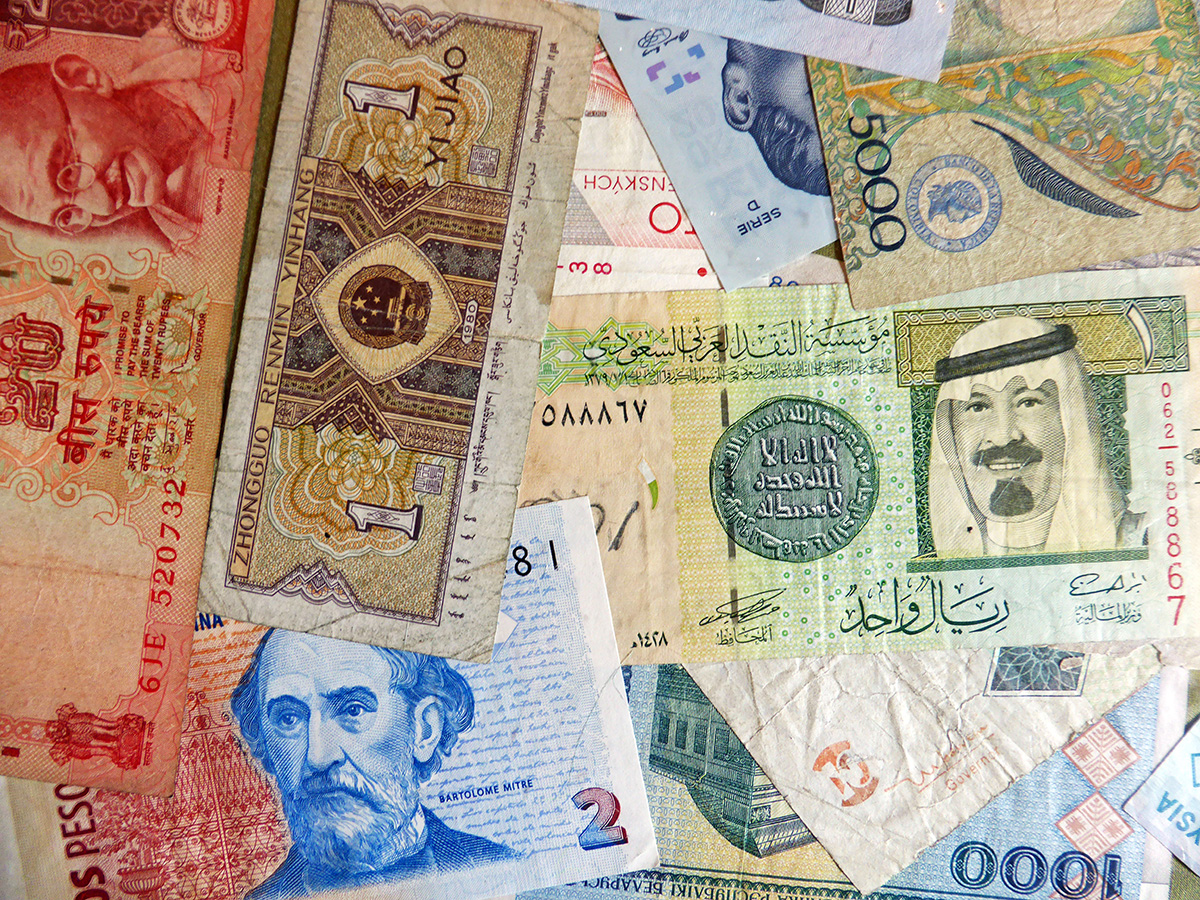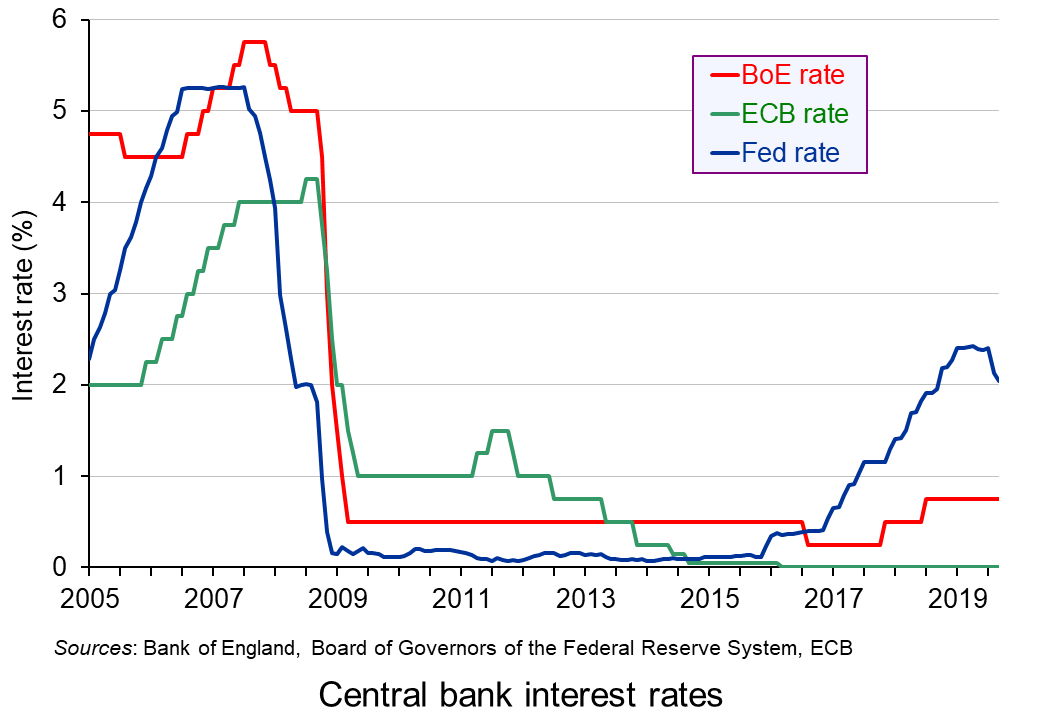 With the prospects of weaker global economic growth and continuing worries about trade wars, central banks have been loosening monetary policy. The US central bank, the Federal Reserve, lowered its target Federal Funds rate in both July and September. Each time it reduced the rate by a quarter of a percentage point, so that it now stands at between 1.75% and 2%.
With the prospects of weaker global economic growth and continuing worries about trade wars, central banks have been loosening monetary policy. The US central bank, the Federal Reserve, lowered its target Federal Funds rate in both July and September. Each time it reduced the rate by a quarter of a percentage point, so that it now stands at between 1.75% and 2%.
The ECB has also cut rates. In September it reduced the overnight deposit rate for banks from –0.4% to –0.5%, leaving the main rate at 0%. It also introduced a further round of quantitative easing, with asset purchases of €20 billion per month from 1 November and lasting until the ECB starts raising interest rates.
The Australian Reserve Bank has cut its ‘cash rate‘ three times this year and it now stands at an historically low level of 0.75%. Analysts are predicting that it may be forced to introduce quantitative easing if lower interest rates fail to stimulate growth.
Japan continues with its programme of quantitative easing (QE) and other central banks are considering lowering interest rates and/or (further) QE.
 But there are two key issues with looser monetary policy.
But there are two key issues with looser monetary policy.
The first is whether it will be sufficient to provide the desired stimulus. With interest rates already at or near historic lows (although slightly above in the case of the USA), there is little scope for further reductions. QE may help, but without a rise in confidence, the main effect of the extra money may simply be a rise in the price of assets, such as property and shares. It may result in very little extra spending on consumption and investment – in other words, very little extra aggregate demand.
The second is the effect on inequality. By inflating asset prices, QE rewards asset owners. The wealthier people are, the more they will gain.
Many economists and commentators are thus calling for the looser monetary policy to be backed up by expansionary fiscal policy. The boost to aggregate demand, they argue, should come from higher public spending, with governments able to borrow at very low interest rates because of the loose monetary policy. Targeted spending on infrastructure would have a supply-side benefit as well as a demand-side one.
Articles
- European Central Bank cuts its deposit rate, launches new bond-buying program
- Can monetary policies help prevent a global recession?
- Draghi’s Utmost Is Still Not Enough
- Draghi puts heat on politicians to boost fiscal stimulus with his ECB swan song
- To infinity and beyond: ECB’s quantitative easing
- The dangers of negative interest rates
- Schwarzman: Europe could enter Japan-style stagnation if governments don’t start spending
- US Fed cuts interest rates for second time since 2008
- Current Federal Reserve Interest Rates and Why They Change
- Federal Reserve Interest Rate Cuts Alone Can’t Prevent a Recession
- Why is the Fed pumping money into the banking system?
- Top of Lagarde’s ECB to-do list: stop QE and democratise monetary policy
- Economists warn Reserve Bank could be forced to print money if rate cuts fail to deliver
- A very large gamble: evidence on Quantitative Easing in the US and UK
- The verdict on 10 years of quantitative easing
CNBC, Elliot Smith (12/9/19)
Investment Week, Martin Gilbert (7/10/19)
Bloomberg, John Authers (13/9/19)
MarketWatch, William Watts (12/9/19)
EJ Insight, Raphael Olszyna-Marzys (2/10/19)
Money Week, Merryn Somerset Webb (7/10/19)
CNBC, Elliot Smith (7/10/19)
BBC News, Andrew Walker (18/9/19)
The Balance, Kimberly Amadeo (19/9/19)
Barron’s, Al Root (4/10/19)
BBC News, Natalie Sherman (19/9/19)
Social Europe, Jens van’t Klooster (25/9/19)
The Guardian, Martin Farrer (2/10/19)
Institute for Policy Research. Policy Brief, Chris Martin and Costas Milas
The Guardian, Richard Partington (8/3/19)
ECB Press Conference
 ECB Press Conference
ECB Press Conference
ECB, Mario Draghi and Luis de Guindos (12/9/19)
Questions
- Explain what is meant by quantitative easing.
- What determines the effectiveness of quantitative easing?
- Why is President Trump keen for the Federal Reserve to pursue more aggressive interest rate cuts?
- What is the Bank of England’s current attitude towards changing interest rates and/or further quantitative easing?
- What are the current advantages and disadvantages of governments pursuing a more expansionary fiscal policy?
- Compare the relative merits of quantitative easing through asset purchases and the use of ‘helicopter money’.